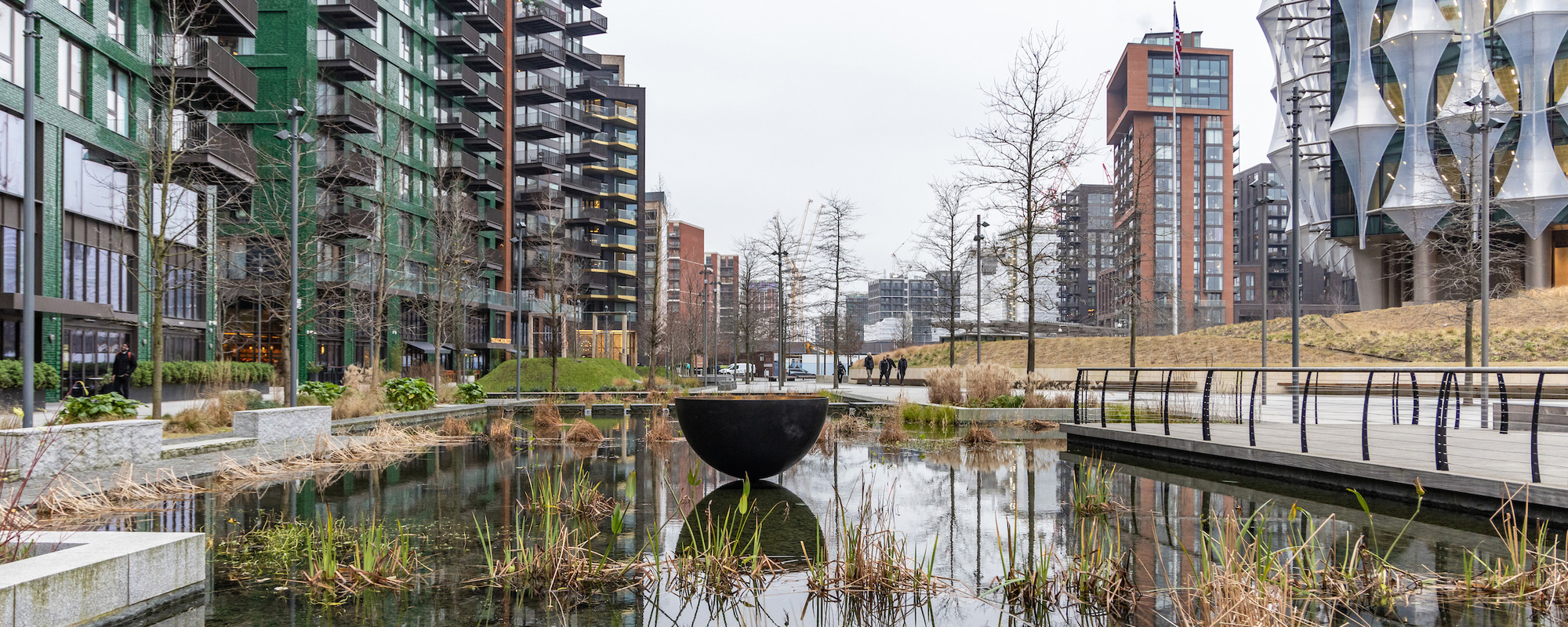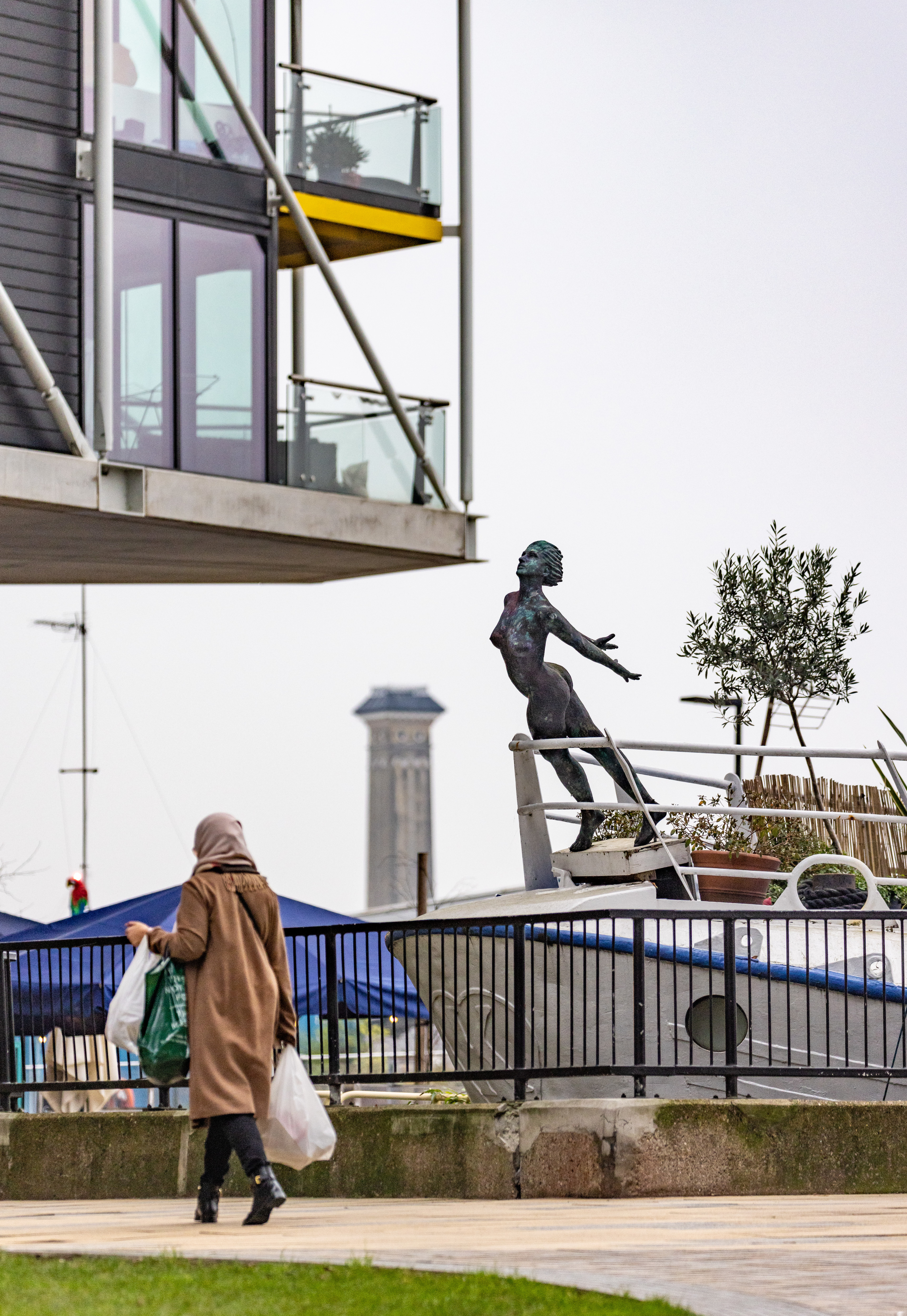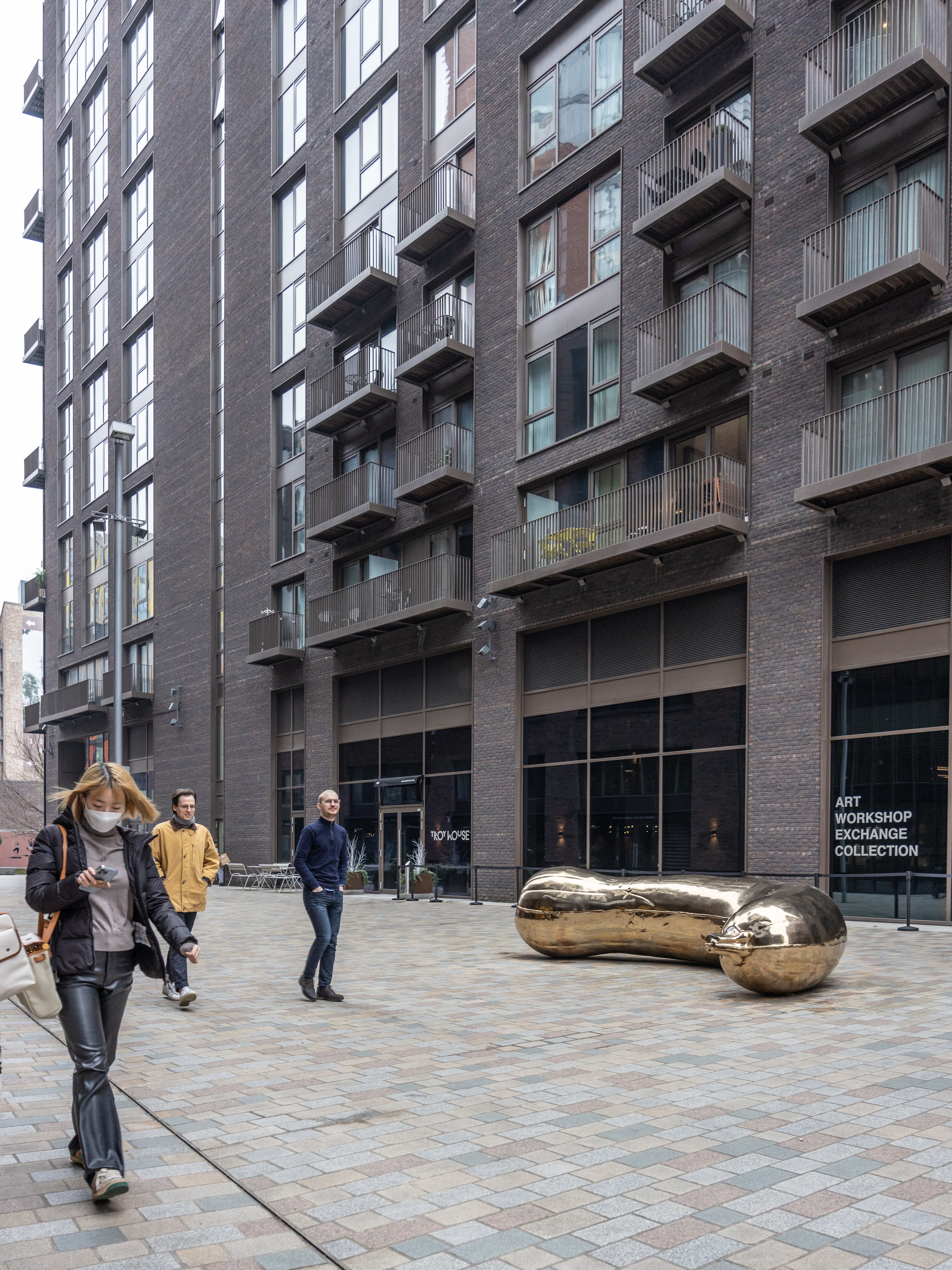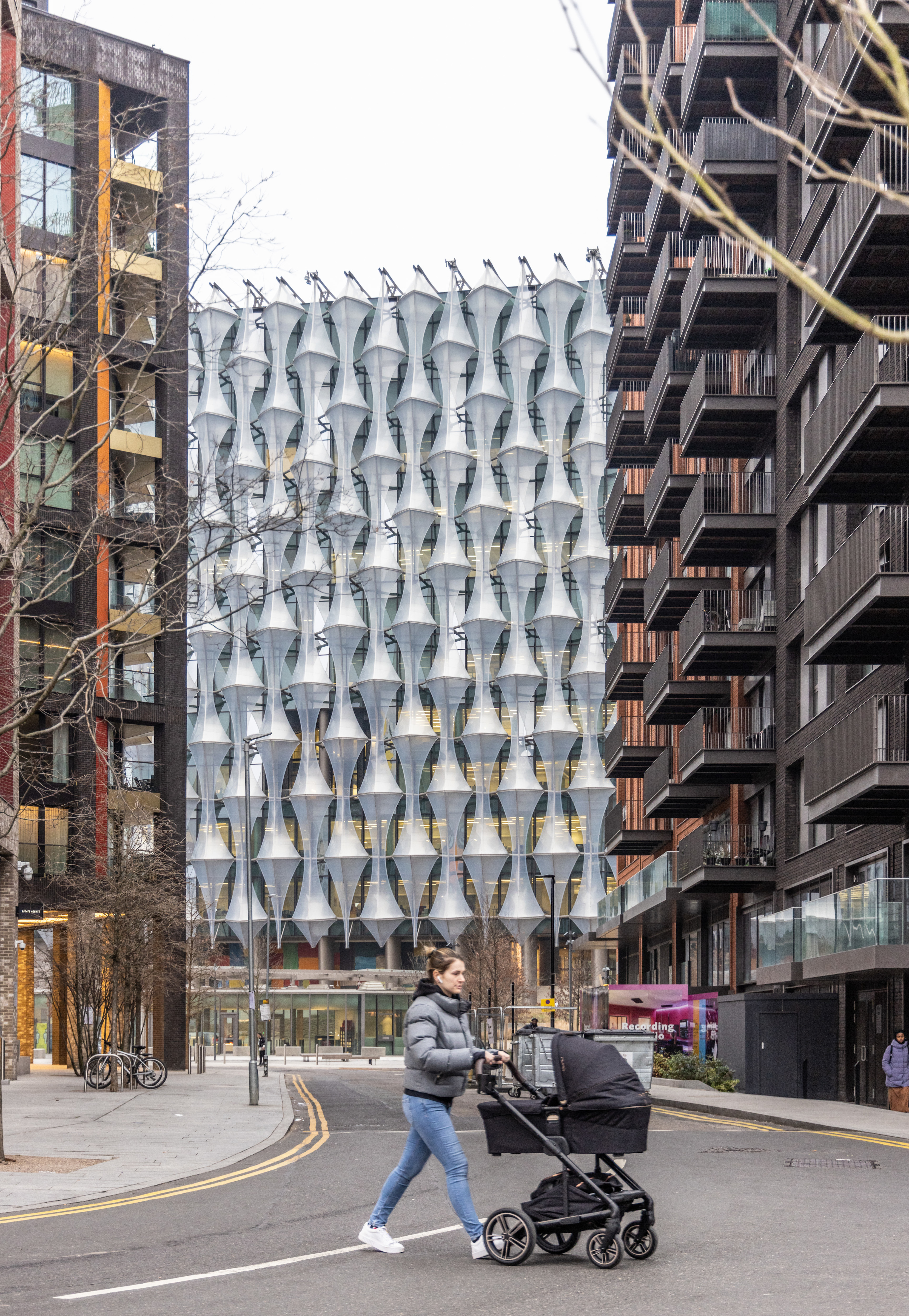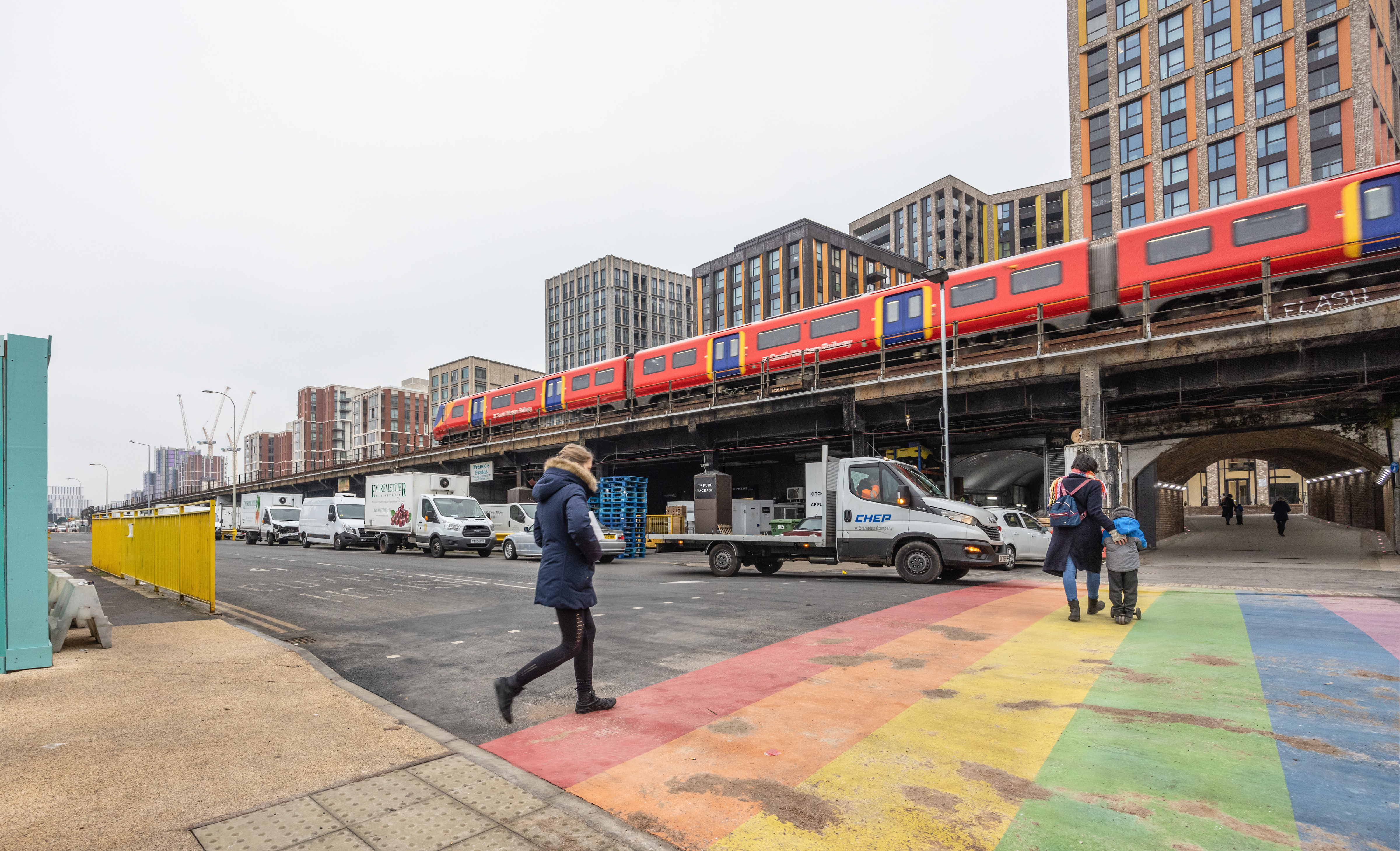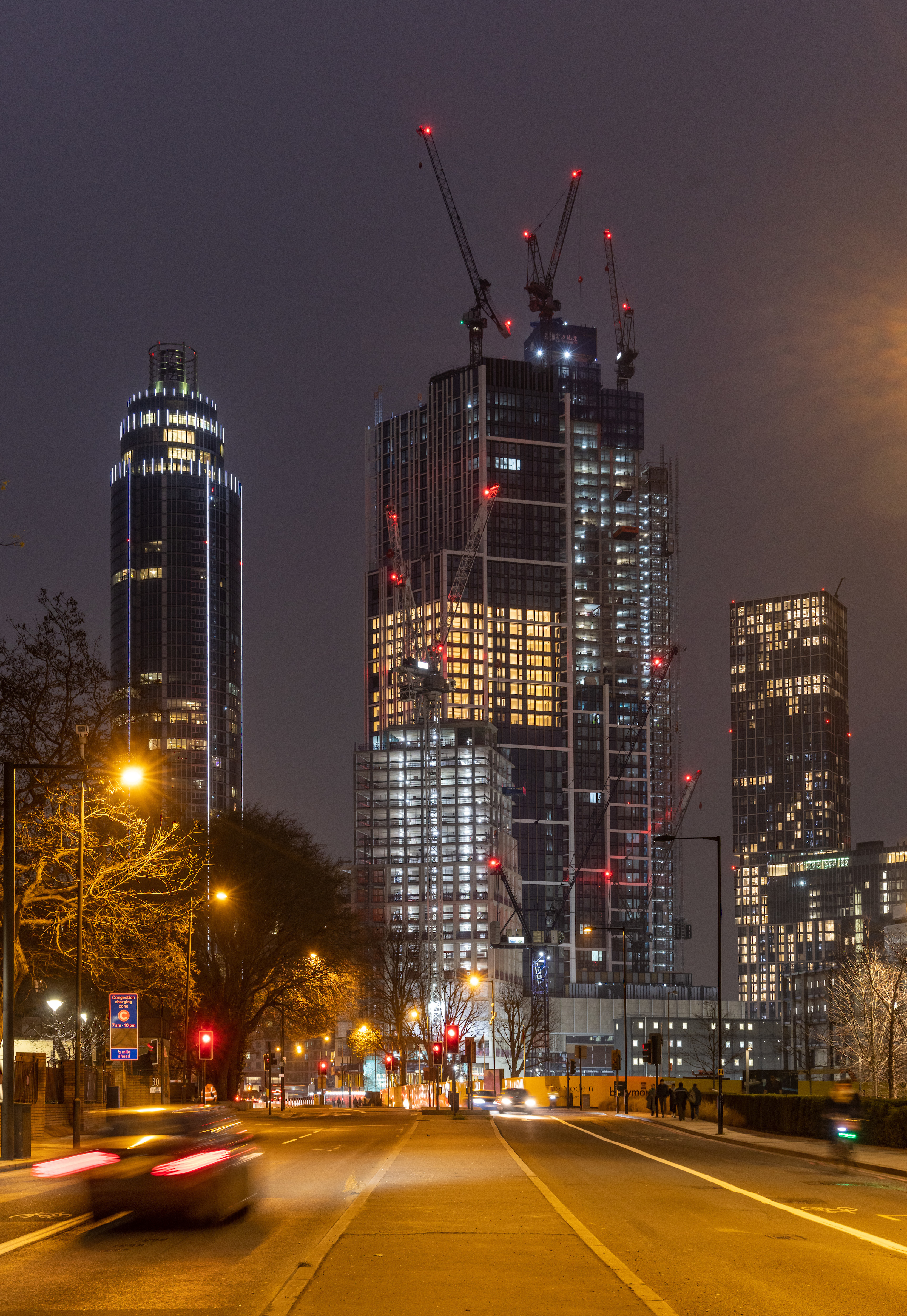Get updates from The Developer straight to your inbox Yes, please!
Placetest: Nine Elms
What is the experience of this nascent place and its people? Anthropologist Caroline Bennett visits Nine Elms and speaks to locals and residents with photography by John Sturrock

Caroline Bennett is a socio-cultural anthropologist, whose work addresses issues of conflict and violence.
I n 2013, Arthur Kay published a short story called Paranoia House. Set in 2062, it describes how Terrence Fyed lives in a constant state of fear and paranoia; of violence, terrorism, and climate emergency. He has adapted his house to protect himself, his fears heightened by direct threats in the area in which he lives - close to the Thames, close to Battersea Power Station, close to the US Embassy. He lives in Nine Elms.
That a dystopian story should be set in the South London neighbourhood says interesting things about the imagination of the area. In many ways, Nine Elms fits a dark futuristic aesthetic - tall and hard-surfaced, with little green and, as of yet, a limited population. Walking around, you are struck by concrete, steel, glass. Everything is high rise. Design elements aiming to emphasise luxury abound: waterfalls near the US Embassy; a sunken garden; glass-fronted restaurants that span whole sides of buildings. There is a static cycling studio, a salon, an Instagrammable cafe filled with flowers and, of course, the infamous Sky Pool - a private transparent swimming pool that floats between two towers.
Everywhere is building work. Cranes litter the skyline. The roads are busy from morning to night with trucks bringing materials or taking rubble away. Tubes pump concrete up to floors in the sky. Large areas are blocked off from public access, surrounded by hoardings advertising the future to come, some with art. The air is full of dust. It’s noisy all the time. But in this construction zone is life. The area is teaming with communities although perhaps not those you might expect. As one of the last major post-industrial zones to be redeveloped in the capital, the Vauxhall Nine Elms Battersea Opportunity Area planning framework was published in 2012 with a forward by London’s then mayor Boris Johnson.
At 227 hectares (561 acres). Nine Elms is the largest regeneration project in London (some claim in Europe), and the plans are staggering in ambition: more than 42 building projects; 20,000 new homes bringing an estimated 30,000 new residents to the area; 25,000 new jobs after construction; 22,000 during; a new town centre; two new tube stations; and a new bridge across the Thames.
The Nine Elms Vauxhall Partnership, led by Wandsworth and Lambeth Councils, includes all the big names, from developers such as Berkeley Group, Barratt, Taylor Wimpey, Ballymore, St Modwen, and Mount Anvil, to architects including Frank Gehry, Zaha Hadid Architects and Foster + Partners, representing billions of pounds of investment.
In any living space there is a common area for bringing people together. In villages, there’s the village green, around which would sit a pub, a church and the village shop. In urban areas, there are squares. As of yet, Nine Elms has no such space. I was wandering about, thinking, "Where would the buskers go?"
Much has been written about the area, with a focus on its extravagance, the international investor funding model, its lack of character and the perceived social segregation - the so-called "spatial apartheid" where facilities and entrances are restricted to certain residents.
Writing for The Guardian, Oliver Wainwright says of Nine Elms: ’’If it is an opportunity area, it has been an opportunity for trialling a new form of social apartheid on an industrial scale."
Edwin Heathcote, architecture critic for the Financial Times, describes Nine Elms as the ’’privatisation of formerly public lands to create an ad-hoc pile-up of towers" and "a massive missed opportunity for a serious piece of city on a remarkable site" Spending time in the area reveals other stories, however; important stories that tell of the wider community and the lives entwined and affected by the Nine Elms development. These arc stories of rhythm and space, flows of traffic, disconnection and exclusion, but also of communities of belonging, widened opportunities, shrinking spaces bringing people closer together, and layers of the past that push through the futuristic architecture to stubbornly complicate new stories told so far.
The interviews take place in Nine Elms in the final months of 2021. Some names have been changed to protect anonymity.
Life in Nine Elms
Frankie moved to the area in 2020 into housing provided by her employer. While she works for them, she remains living there. ’’This is a construction zone" she says. "I live in a construction zone." For Frankie, the height of the buildings and their proximity to one another makes establishing community difficult. The towers block out the light, there is too much concrete. "There’s nothing homey or comfortable or aesthetically pleasing about this area," she comments.
Frankie uses the supermarkets - Waitrose in New Union Square and Sainsbury’s now that a cut-through to Wandsworth Road has opened up. But for social events, or just finding spaces to relax, she leaves Nine Elms, heading towards Battersea or further out. "That’s where the community places are," she notes. ’"[Nine Elms] is just construction. There’s nothing. I can’t think of anything thats over there. It’s just something in between Battersea and Vauxhall itself ... It’s a place that you go through. It’s not a place that you go to."
Frankie’s house is one of the new blocks at Nine Elms, close to Battersea. There are things she loves about the area: the park, the Uber Boat, the fact that she can walk to work if she wants to. But overall, it’s not an area she would choose. "This isn’t what I think of when I think about London," she comments. "I wanted something, I don’t know, Victorian, I guess. This is so modern. It doesn’t feel like I’m in London. It feels like I could be in any city. It’s basically soulless."
The "soullessness" of Nine Elms is noted by others, but what it means varies. For the people I speak to, it relates to community as much as design. Although the high-rises feel generic and the restaurants have the look of a thousand others, the crux of it is what this aesthetic engenders: the inability to be a local. As Frankie notes: "I think part of having a community is feeling like, ’Oh, this is our spot. Yeah. This is our pub. This is our cafe." There’s nothing like that around here to set your mark on."
Mila moved to Nine Elms in 2017, only moving out last year when the opening of the Sky Pool and the two new tube stations increased her rent to a level she could no longer afford. In general, Mila feels very positive about Nine Elms. As someone with an underlying health condition and busy with postgraduate study, being somewhere with all the amenities on tap is attractive. She was looking for a new-build with its related benefits for accessibility. She was also drawn to the location: "There’s a certain cachet to living in Nine Elms," she notes. According to Zoopla, the average sold price for a property in the area is £675,483.
Like Frankie, Mila notes a lack of community. "There are a lot of empty units, sadly; people who are not living there full-time. And that makes it hard to know your neighbours and have that community atmosphere." There are places to go, Mila says, but as a local you aren’t guaranteed to get in. Bars and restaurants stretch along the riverside from Vauxhall through Nine Elms all the way to the power station. It’s a new hub for London, but if you live in the area, it’s hard to find space. "It’s just a bit frustrating,’’ Mila comments. ’’When you live there and you can’t get a table ... especially after Covid. Part of what you want to do when you live in an area is go "I’ve got my local restaurant that I really like. A cafe that I go to." Mila went down to the pub when the Euros were on, but because she hadn’t booked, there was no space, and nowhere to go nearby. "That’s not what a local should be like," she says.
The lack of social space isn’t only a problem for residents. Everyone mentions it. There’s an assumption that it’s the nature of the buildings that makes it hard to create community, not only because so many units remain empty, but because they are high rather than wide. "This is one of the very few areas that is almost exclusively, if not completely, high or medium rise," says Betsy Blatchley, a reverend who works in the area and lives close by. "There are virtually no houses in Nine Elms. And that has an impact."
The lack of social space isn’t the only a problem for residents. Everyone mentions it. There’s an assumption that it’s the nature of the buildings that makes it hard to create community, not only because so many units remain empty, but because they are high rather than wide.
In 2018, the Diocese of Southwark appointed Blatchley as pioneer minister in the arts for the Church of England, leading the Nine Elms Art Ministry. Seeing the plans for development in the area, the diocese saw the arts as a route to connect with the growing population. She finds the area and her work exciting but the nature of Nine Elms has made it challenging. Although Nine Elms is not a gated community, there are elements of restriction. Its vertical nature means people don’t connect with one another in the same way as inhabitants with front doors do. Many of the developments also come with associated services: their own gym, pool, concierge, laundry and garden. People don’t need to leave their building and, even when they do, places to come together are limited.
The commons
In any living space there is a common area for bringing people together. In traditional villages, there’s the village green, around which would sit a pub, a church and the village shop. In urban areas, there are city squares. With Nine Elms Park due to complete in 2025, as of yet, Nine Elms has no such space. New Union Square has the name of one but its actually a pedestrianised pathway connecting Nine Elms Lane and Malthouse Road. I noticed the lack of a common when l was wandering about, thinking: "Where would the buskers go? Where would you put on plays? Play music? Dance?"
Astrid, who lives nearby, comments: "There’s nowhere to sit and stay. Well, there is, but only if you’re buying something. But there’s nowhere to sit and have a natter. And where would I take my child?’’
At the heart of Nine Elms is the US Embassy, the most secure building in Britain, with its crescent moat, bomb-blast zone, Faraday cage and high-tech surveillance. Like many other developments, all the spaces that appear to be public are in fact privately owned, and while they may be accessible to the public, their owners can impose restrictions on access and use, for example limiting photographs, moving people on, or banning protest, making them less than public in reality. At Nine Elms, Wandsworth is said to be enacting London’s first charter for privately owned public space to secure the space for leisure and wellbeing. What counts as Nine Elms varies depending on who you ask and where you look. The Vauxhall Nine Elms Battersea Opportunity Area spans from Vauxhall Bridge all the way clown to Battersea Park, encompassing the power station and surrounding areas.
This is the development area as identified in the original 2004 London Plan, which transformed the approach of London development. Instead of focusing on boroughs and their related centres (Brixton and Wandsworth), it identified underdeveloped and neglected brownfield sites on the peripheries: King’s Cross in the north, Liverpool Street to the east, Nine Elms in the west.
In contrast, what Wandsworth and Lambeth call "Nine Elms on the South Bank" stretches all the way from Lambeth Palace to Battersea Park, and southwards to include Lambeth College on Wandsworth Road. This is an aspirational area that encompasses cultural and community policies as well as the wider building work.
The district of Nine Elms itself denotes the area around the new US Embassy, from Vauxhall Cross down Nine Elms Lane to just south of New Covent Garden Market. The different names and geographies reflect the dizzying array of organisations, plans and strategies involved in the redevelopment - a collaborative affair between the Greater London Authority, Lambeth and Wandsworth Councils, the London Development Agency, Transport for London and English Heritage. The development’s implementation involves yet further parties: 42 different developers, many of whom work with multiple partners and contract out aspects of work, leaving the final count almost impossible to quantify. Each of these comes with its own idea of where and what Nine Elms is, and a development plan related to this.
Art to create community
With so many different investors, developers, businesses and buildings, it is hard to create the kind of connections that make community. In this regard, Blatchley is someone who can make such connections. She works across the development with the councils, developers, local schools, community groups and individuals. Although she is a minister, she says her role is to connect people - "to make ways for people to encounter one another, and to create community through that." The church is doing this through the arts.
It’s been standard practice to involve the cultural industries in urban redevelopment - for the optimistic, as a way to bring meaning, depth and culture to an area; for cynics, as a way to paper over issues of discomfort, disingenuities and disappointments. At Nine Elms. key stakeholders from government, developers and the Church of England have seen the arts as a means to connect with the community, made visible in large-scale commissioned spaces, such as the Thames Walk pavilion by architects Studio Weave with print artist Linda Florence, to art on hoardings and cladding around the area.
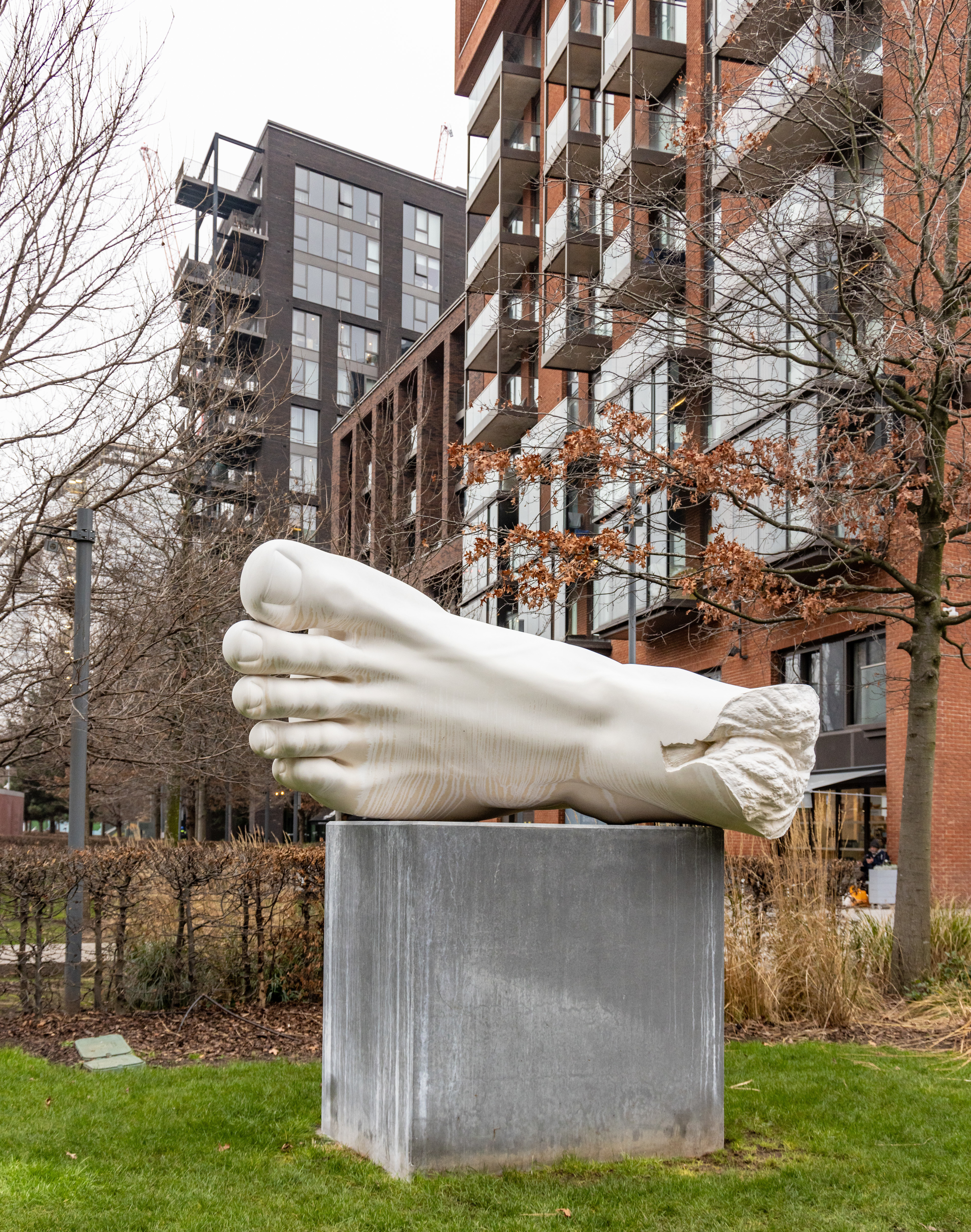
Art has provided a significant opportunity to draw people into Nine Elms. Throughout December, the Nine Elms Advent Calendar Art Trail (organised by Nine Elms Art Ministry) displayed 24 installations across the redevelopment zone in an attempt to connect new and established communities. The Line of Light festival, mapping the route of the new Northern Line extension, brought people from Oval via Stockwell past Nine Elms tube station to the power station.
The council is encouraging cultural anchor tenants to connect with areas neglected by the development, such as the Patmore Estate and local schools. The newly opened Merchants Way ("the cut-through", as everyone calls it) has helped with this. Wide, open and sided by colourful boarding, with a rainbow crossing connecting to Arch 42, it creates a route under the railway lines, more than halving the time between Wandsworth Road and Nine Elms Lane, bringing these two communities closer together. But there remains a disconnection between old and new.
From the outskirts, this disconnect net looks problematic. But as with every place, there are a multitude of realities and ways of looking. Nine Elms is a story of redevelopment and gentrification - but not the same old story. This is not Elephant and Castle, where existing homes were destroyed to make way for new estates, displacing communities and creating demographic change through development. Nine Elms was a post-industrial brownfield site; nobody was decanted or relocated.
Some locals express concern about development creep. Lambeth College on Wandsworth Road is inside the development zone and there are plans to build a 27-storey student residence next to the existing college. It will overshadow three Victorian terraces that remain in the area, blocking their sunlight. There’s also been an increase in flooding to the area. Laura says: "The Victorian drains are bursting. Maybe they’d burst anyway, but is the development making it happen more often?
World leading
There’s something aspirational to Nine Elms. It’s an area of firsts and mosts. The biggest redevelopment zone in London. The world’s first swimming pool bridge. The longest roof garden in London. The tallest residential building in Europe. These statements are reminiscent of Dubai, a city created out of a desert, which relied on impressive architecture and world-record claims to attract businesses and tourists. Nine Elms is trying to make a global splash, and there’s something exciting about that.
Laura and Pat, Astrid, Ursula, Liam and Matt all live in a community close to the new Nine Elms tube station. Each of them owns their place, bought because they want to build a home. They all commented favourably on the transport links and facilities available. The new Underground station was part of the draw for Laura, Pat, Liam and Matt in coming to the area. Ironically, Trump refused to visit the new US Embassy on his visit in 2018 because of its "lousy location’’ - a fact that for some in the area is a point of pride.
For Ursula, who moved here in 1986, the tube is a bonus, but also irrelevant. Now that the cut-through link has opened between Wandsworth Road and Nine Elms Lane. she is enjoying the changes. "I love the way that they’re trying to connect this side with that side," she says. "it’s great that you can walk from here and get to another coffee shop in 10 minutes - to District (I love it!), to a posh supermarket." They enjoy the buzz of the new restaurants and cafes, and connections to the river. They feel Transport for London’s redesignation of the area to Zone 1 adds status to their homes.
There is a wealth divide between Nine Elms and surrounding areas as well as within the developments themselves, although accusations os social apartheid are frankly ridiculous. Weaponising a term of violence by using it to describe access to gym memberships and a swimming pool is insulting. That said, aspects of the wealth gap in the area can feel obscene.
The overall development plan references placemaking as a key part of the restructure with mixed communities of living: residences, shops, leisure facilities and space. But the full development, including many of the key aspects aimed at creating community are not yet in place. The linear park, the community hub, the new school, cinema and theatre, and the services needed to support community living like doctors and dentists and garden centres, for example, aren’t expected to finish until 2025. That it has not yet created a sense of community might be down to design but it could also be a function of time and construction phasing. Places are created by people and their movement and relationship with space. According to geographer Doreen Massey, they are formed through an ongoing negotiation between space, community, politics, history, economies. and time. They cannot be designed, because they are organic, and attempts to overmanage community can create barriers to belonging.
The wealth gap
There is a wealth divide between Nine Elms and the surrounding areas as well as within the developments themselves, although accusations of social apartheid are frankly ridiculous. Weaponising a term of violence by using it to describe access to gym memberships and a swimming pool is insulting. That said, aspects of the wealth gap in the area can feel obscene. Arriving at Nine Elms to conduct interviews, I came via a food bank in Vauxhall where I volunteer. Every week it feeds between 30 and 40 families, relying on donated food from local shops and people, much of which is past its best. This is only one of scores of food banks in the area - small scale, run by religious organisations of all types, not recorded by the government, yet depended upon by many in the local community. As I moved from one space to the other, the difference was stark. Our shabby food bank is messy and vibrant, full of life, chatter and normalcy. As I crossed the Wandsworth Road and made my way to the cut-through, the surroundings began to change. Colour and disorganisation faded into browns and straight lines. As I walked into the cafe where I was to meet the manager, the concierge greeted me by calling me ma’am, the most generic of all terms. The coffee cost almost £5.
Exclusion doesn’t only happen through forced relocation. As other academics studying urban redevelopment have pointed out, it can happen through spatial design and rhythmic restructuring. The Nine Elms architecture is built in such a way as to disguise deprivation in the area and keep it away. The housing shelter that used to be at Vauxhall bus station has been shifted backward out of view. While the power station has a few areas to rest, the only areas to sit in Nine Elms are big concrete blocks outside the US Embassy - too far apart to encourage conversation, overlooked by high rises and glass-fronted bars. Some see these aspects as positive. To Archie, who moved jobs from Soho to Nine Elms to manage the restaurant at Linnaean (he has since left), they are signifiers of safety: the area is lit, it’s clean, there’s no space to loiter or hide. Ironically, according to the Mayor of London’s crime map, the area has higher crime rates than neighbouring wards in Wandsworth, and the most recent numbers show crime is rising.
What makes this area feel safe and attractive for some is exclusionary to others. If the weather is bad, there’s nowhere to go except into a place where you have to buy something. When the builders break for lunch, they go to the riverside where there are wooden benches, open sky, and a more welcoming feel. If you are a rough sleeper, the only place to find shelter is the Nine Elms Pavilion on the riverside, opened in 2018. Though, as Liam points out. the problem isn’t the developers, or the businesses per se. They are profit-driven enterprises. The issue is the government policy to privatise public space.
Mila says she moved out not only because of the rent increase but because she felt the price points at Nine Elms attract people with lifestyles not commensurate with everyday life: parties at all times; loud roaring cars at all hours of the night; cafes that open at 8 or 9am, and close at 3pm. There’s no place for shift workers to grab coffee or lunch at a nonstandard hour. It may suit certain lives. but it forces others to find lives elsewhere.
Rhythms and communities of belonging
If you stop and listen, Nine Elms is teaming with life. From 7am, a stream of construction workers emerge from Vauxhall Station, stopping at Tesco, grabbing coffee from Pret. They arrive from all over London, and many originally from elsewhere. A queue starts to form outside the US Embassy around 7:15. Just before eight, parents start moving through with children - pushing buggies, or with kids on scooters and bikes. By 8:30, District - the most approachable coffee shop - is filled with people, some sitting in, though mostly grabbing takeaway coffees and pastries on their way to work. Then come the dog-walkers and the runners. taking advantage of the river walkway and the spaces between the buildings, linking Lambeth and Wandsworth Road to the river. Throughout the day, the area is covered in noise, dirt, movement and laughter. The flow reverses around six o’clock, depending on the day, as workers go back home.
Communities of belonging are beginning to emerge. With Covid, many businesses that had planned to open were delayed or closed, with a few having found new ways of offering services. Places have started to open up again now but, being a brand new area in a post-lockdown era, forecasting was hard. Some businesses got it wrong. Covid brought them together to help each other. When an establishment ice machine broke down, another business gave them ice. There are several WhatsApp groups for residents. When Mila was shielding, her neighbours took her bins out, got her shopping and looked out for her.
The disconnection between Nine Elms and its surrounding communities is also changing. As Ursula put it, the area is shrinking, and with that comes integration. "Integration is something thats interesting to think about," she says. "I think it’s something that’s going to take time. But I think that [will happen] the more the demographic changes, as the demographic gets younger"
Nine Elms has a long and varied past, but has always been a place of new ventures as well as contrasts. In 1760, the artist Samuel Scott, a contemporary of Hogarth, painted the original Nine Elms and the slums behind it, as viewed from across the river in Pimlico. Along with the slums were gas works. candle makers, and other industries. In the 19th century, Charlotte Despard, a wealthy campaigning socialite for adults and then women’s suffrage, chose Nine Elms as her battleground, moving there in the 1890s. The cabinets first working class MP, John Burns, was born in Vauxhall. The first station for the London and South Western Railway was at Nine Elms. After it finished transporting passengers, more than 800 steam locomotives were built by the railway at Nine Elms.
In the latter half of the 20th century, the area was all but abandoned. The first phase of the power station, Battersea A, opened in 1935, it was Grade II listed in 1980. and decommissioned in 1983. The cold store at the top of the road, built in 1964 on Land previously used by the South Metropolitan Gas Works (which had itself been built on the site of a former tidal mill), was disused from 1979 and demolished in 1999. For years, Nine Elms was a post-industrial wasteland, inaccessible to most. It took a long time for the new development to get off the ground, but it’s now well underway.
Walking around Nine Elms, it feels a little Haussmannian; everything razed to the ground to begin again. But if yon look closely, elements of the past jut into the present; pieces of history that refuse to be erased. Along the river’s edge are Riverside and Elm Quay Courts - red brick developments from the 1980s that break up the skyline of the new-builds surrounding them. There’s Tideway Village, a collection of houseboats which fought to remain. The terracotta relief River God (Father Thames), constructed in 1988, refers to the millennia that people have been worshipping the Thames. often in the very area now being redeveloped. There’s Battersea Power Station itself, an icon, a megastructure, a monument, now corralled by new developments to the south.
When the Thames recedes, mudlarkers come and collect what they find - glass bottles and old clay pipes. You can see remnants of places that came before - a stratigraphy of the past, all but erased by the present development. Some of these are significant: upstream from Vauxhall Bridge are the remnants of a Bronze Age causeway estimated to be from around 1500BC, and downstream there are six prehistoric timber piles from around 6,000 years ago - London’s oldest structure, discovered in 2011 alongside Mesolithic tools and Neolithic pottery. It sits at the confluence of the Thames and the Effra - streams that existed in south London but have since been culverted and used for sewage. Less romantic but equally vital is the Thames Water Heathwall pumping station - an ugly grey building that dominates Nine Elms Lane where it stands.
"There is a resurrection of Nine Elms right now and the area is completely changing," Archie says at the end of our interview. "It’s a new history starting." The thing about history is that it’s never stagnant and it never completely disappears. In so-called "placemaking"; previous pasts are integrated in the present, even in industrial zones and on brownfield sites that seem empty and ripe for new life. While he looks to the future, the past appeals to Archie too: "There’s so much history, I can see that," he says. ’’These old pipes, the people that were standing next to the piers, smoking a pipe, talking."
Caroline Bennett is associate research fellow in cultural anthropology at the School of Social and Cultural Studies, Te Herengu Waka - Victoria University of Wellington, New Zealand
If you love what we do, support us
Ask your organisation to become a member, buy tickets to our events or support us on Patreon
Sign up to our newsletter
Get updates from The Developer straight to your inbox
Thanks to our organisation members
© Festival of Place - Tweak Ltd., 124 City Road, London, EC1V 2NX. Tel: 020 3326 7238
